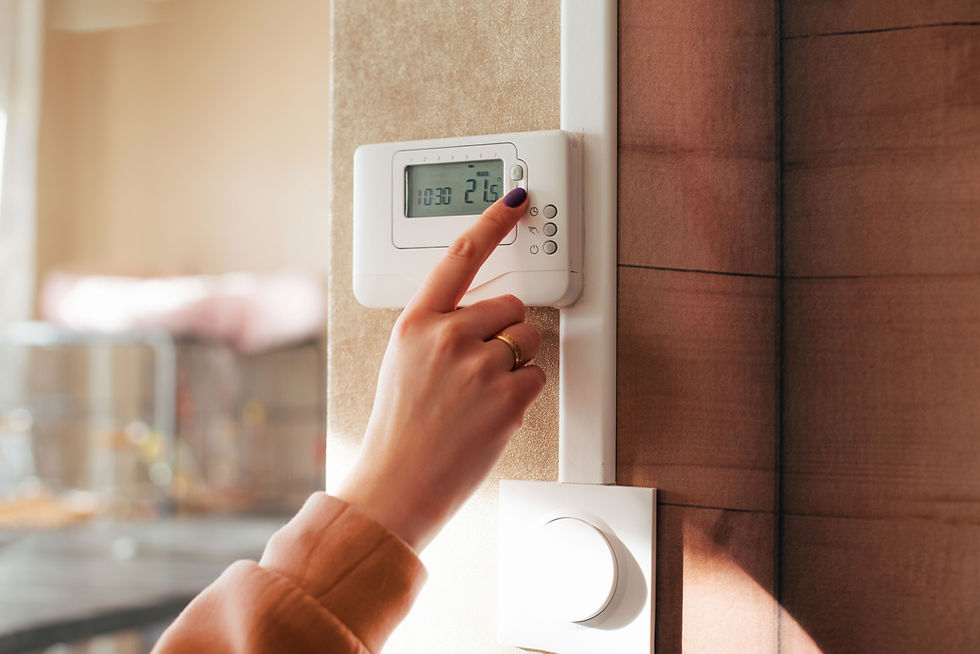11 TIPS TO PREPARE FOR YOUR HOME FOR WINTER
- devonte4
- Nov 19, 2024
- 4 min read

1. Drain your lawn-irrigation system to save sprinklers from breaking
Lawn irrigation systems are not buried deep, so they can freeze and burst during cold weather, creating a potentially expensive problem and mess. Hire a professional to drain them and check for damage to fix before winter sets in.
2. Turn off exterior faucets to prevent pipes from freezing
When prepping your home for winter weather, turn off water to outdoor showers or spigots for hoses. Most installed before 2007 are not frost-proof. You will find they are typically controlled by a central shut-off valve, separate from your indoor water system, inside your home.
3. Prune trees or shrubs to avoid potential house damage
Trimming back vegetation is a key step in preparing your home for winter. Heavy snowfall or an ice load can damage decorative shrubs. Make sure that no branches overhang and threaten your home or electrical lines. Your power company may provide free pruning to protect their transmission lines. When doing it yourself, use care on ladders, with chainsaws, and around power lines.
4. Get your roof inspected to identify any loose or missing shingles
Your roof is critical to your home’s structural integrity. While you can do a visual inspection yourself, what you can’t see represents the most risk. Flashing around pipes and near your eaves under shingles can leak without you seeing issues.
A professional can do a comprehensive inspection, clean off leaves and make necessary repairs. If you add this step to how to prepare your house for winter, you will prevent a leak in the middle of winter that will be dangerous and expensive to repair.
5. Get your chimney inspected to help prevent chimney fires
Your chimney can quickly get covered in flammable creosote. The fireproof lining breaks down over time. Poor venting can cause smoke and fumes to leak into your home. An annual inspection and cleaning can save you costly repairs, or worse, a devastating fire or carbon monoxide poisoning.
Prepping your home for winter means removing bird or animal nests, ensuring mortar, bricks, chimney cap and spark arrester are in good condition and that your chimney draws efficiently. Also inspect flues to make sure they close and seal well, preventing drafts and heat loss.
6. Clean your gutters and inspect downspouts to avert potential leaks
Clogged rain gutters and blocked downspouts put your home at risk in multiple ways. Clogged gutters lead to ice dams that create roof leaks. Standing water on your roof also causes the roofing material to decay.
In a storm, gutters filled with gunk can freeze, adding weight that causes them to sag or fall off altogether. Clogged downspouts or downspouts that don’t direct water from your foundation can lead to foundation cracks and water in your basement. When preparing your house for winter weather, do not neglect this critical step.
7. Drain the fuel from your small gas-powered engines to winterize them
Gasoline and diesel both thicken and decay over time in low temperatures. Moisture can make the issue worse. Leaving fuel in your gas-powered devices and fixtures over the winter can shorten their useful lives and interfere with their proper operation.
Drain fuel from lawn mowers, weed whackers, power washers or anything that has a gas-powered motor. Fuel remaining in their engines will decompose, creating an effect called varnishing. The carburetor and other engine parts gunk up, making the motor difficult to start in the spring.
While gasoline doesn’t freeze solid until -40°F, it does thicken and damage engines well above that level. Also, gasoline decomposes with time, being good for only about three months. You can add a stabilizer to keep it fresh a bit longer.
8. Restock winter essentials to get ahead
Plan ahead and stock up on winter essentials like ice melt, firewood, shovels or a snowblower and gasoline, properly stored and with an added stabilizer, before severe weather sets in. If you wait, you may find empty shelves at your home center when a blizzard or ice storm is in the forecast.
9. Reverse your ceiling fans for more energy saving
Your ceiling fan should rotate in the opposite direction from how it turns in the summer. Reversing the direction of your fan creates an updraft that pushes down warm air that rises to the ceiling. Circulating that warm air throughout the room will make it more comfortable and will reduce the load on your heating system, thus helping to save energy in the winter.
10. Caulk or weather strip around windows and doors to avoid drafts
Look for drafts around your home. Gaps around windows, doors, cracks in your foundation and spots where cables and pipes enter are prime culprits for letting cold air in. You can close them with various types of weatherstripping. Caulk works for smaller and odd-shaped gaps. This easy, fast, and inexpensive prepping your home for winter will slash your heating bill.
11. Tune up your home’s heating system to make it run more efficiently
One of the most important considerations when it comes to how to prepare your house for winter is doing seasonal maintenance on your heating system. Replacing filters, cleaning pipes, ducts and motors and giving it a solid tune-up ensures it is running efficiently. You’ll be able to spot issues and repair them before cold weather arrives. In certain regions, Constellation offers heating inspection services.

Comments